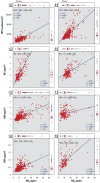Evaluating multipollutant exposure and urban air quality: pollutant interrelationships, neighborhood variability, and nitrogen dioxide as a proxy pollutant
- PMID: 24225648
- PMCID: PMC3888565
- DOI: 10.1289/ehp.1306518
Evaluating multipollutant exposure and urban air quality: pollutant interrelationships, neighborhood variability, and nitrogen dioxide as a proxy pollutant
Abstract
Background: Although urban air pollution is a complex mix containing multiple constituents, studies of the health effects of long-term exposure often focus on a single pollutant as a proxy for the entire mixture. A better understanding of the component pollutant concentrations and interrelationships would be useful in epidemiological studies that exploit spatial differences in exposure by clarifying the extent to which measures of individual pollutants, particularly nitrogen dioxide (NO2), represent spatial patterns in the multipollutant mixture.
Objectives: We examined air pollutant concentrations and interrelationships at the intraurban scale to obtain insight into the nature of the urban mixture of air pollutants.
Methods: Mobile measurements of 23 air pollutants were taken systematically at high resolution in Montreal, Quebec, Canada, over 34 days in the winter, summer, and autumn of 2009.
Results: We observed variability in pollution levels and in the statistical correlations between different pollutants according to season and neighborhood. Nitrogen oxide species (nitric oxide, NO2, nitrogen oxides, and total oxidized nitrogen species) had the highest overall spatial correlations with the suite of pollutants measured. Ultrafine particles and hydrocarbon-like organic aerosol concentration, a derived measure used as a specific indicator of traffic particles, also had very high correlations.
Conclusions: Our findings indicate that the multipollutant mix varies considerably throughout the city, both in time and in space, and thus, no single pollutant would be a perfect proxy measure for the entire mix under all circumstances. However, based on overall average spatial correlations with the suite of pollutants measured, nitrogen oxide species appeared to be the best available indicators of spatial variation in exposure to the outdoor urban air pollutant mixture.
Conflict of interest statement
The authors declare they have no actual or potential competing financial interests.
Figures




References
-
- Bergeron O, Strachan IB.2012Wintertime radiation and energy budget along an urbanization gradient in Montreal, Canada. Int J Climatol 32137–152.; 10.1002/joc.2246 - DOI
-
- Brook JR, Burnett RT, Dann TF, Cakmak S, Goldberg MS, Fan X, et al. Further interpretation of the acute effect of nitrogen dioxide observed in Canadian time-series studies. J Expos Sci Environ Epidemiol. 2007;17:S36–S44. - PubMed
-
- Dobbin NA, Wheeler AJ, Smargiassi A, Bartlett S, Liu L, Shutt R, et al. Lung inflammation among children with asthma exposed to industrial and traffic pollution [Abstract 936]. In: 23rd Annual Conference of the International Society for Environmental Epidemiology (ISEE), 13–16 September 2011, Barcelona, Spain. 2011. Available: http://ehp.niehs.nih.gov/isee/PDF/isee11Abstract00936.pdf [accessed 3 December 2013]
Publication types
MeSH terms
Substances
LinkOut - more resources
Full Text Sources
Other Literature Sources
Medical
Molecular Biology Databases

